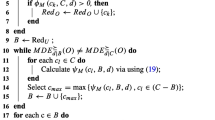Abstract
Attribute reduction plays an important role in pattern recognition and machine learning. Covering-based rough sets, as a technique of granular computing, can be a useful tool for studying attribute reduction. Topology has a close relationship with rough sets and plays a significant role in attribute reduction in information systems. So it is meaningful to combine topology with rough sets to address the problems of attribute reduction. In this paper, we mainly discuss and address the problem of attribute reduction in incomplete information systems with dependence space induced by topological base. Firstly, we investigate the topological structure induced by covering-based rough sets and some characteristics of the topological structure are presented. Secondly, a new type of dependence space is constructed in terms of the base of topological structure, and some characteristics of the dependence space are investigated. Finally, we apply the obtained results of the space to the attribute reduction in incomplete information systems. Especially, a discernibility matrix is defined for the attribute reduction in incomplete information systems.
Similar content being viewed by others
References
Pawlak Z (1991) Rough sets: theoretical aspects of reasoning about data. Kluwer Academic Publishers, Boston
Dai J (2013) Rough set approach to incomplete numerical data. Info Sci 241:43–57
Chen D, Zhang W, Yeung D, Tsang E (2006) Rough approximations on a complete completely distributive lattice with applications to generalized rough sets. Info Sci 176:1829–1848
Zakowski W (1983) Approximations in the space \((u, \pi )\). Demonstratio Mathematica 16:761–769
Shi Z, Gong Z (2010) The further investigation of covering-based rough sets: uncertainty characterization, similarity measureand generalized models. Info Sci 180:3745–3763
Tsang E, Chen D, Yeung D (2008) Approximations and reducts with covering generalized rough sets. Comput & Math Appl 56:279–289
Ma L (2012) On some types of neighborhood-related covering rough sets. Int J Approx Reason 53:901–911
Zhi P, Pei D, Zheng L (2011) Topology vs generalized rough sets. Int J Approx Reason 52:231–239
Kondo M (2005) On the structure of generalized rough sets. Info Sci 176:589–600
Lin PLJ (2009) Relation reduction of information systems b ased on interior and its application. Syst Eng Elect 31:1353–1357
Yu H, Zhang W (2014) On the topological properties of generalized rough sets. Info Sci 263:141–152
Lashin E, Medhat T (2005) Topological reduction of information systems. Chaos Solitons Fractals 25:277–286
Chen D, Wang C, Hu Q (2007) A new approach to attribute reduction of consistent and inconsistent covering decision systems with covering rough sets. Info Sci 177:3500–3518
Qin K, Yang J (2008) Generalized rough sets based on reflexive and transitive relations. Info Sci 178:4138–4141
Yao Y (1996) Two views of the theory of rough sets in finite universes. Int J Approx Reason 15:291–317
Qin K, Pei Z (2005) On the topological properties of fuzzy rough sets. Fuzzy Sets Syst 151:601–613
Zhu W, Wang F (2003) Reduction and axiomization of covering generalized rough sets. Info Sci 152:217–230
Zhu W (2009) Relationship between generalized rough sets based on binary relation and covering. Info Sci 179:210–225
Engelking R (1989) General topology. Polish Scientific Publishers, Warszawa
Novotny M, Pawlak Z (1991) Algebraic theory of independence in information systems. Fundamenta Informaticae 14:454–476
Medina J (2012) Relating attribute reduction in formal, object-oriented and property-oriented concept lattices. Comput Math Appl 64:1992–2002
Wang X, Zhang W (2008) Relations of attribute reduction between object and property oriented concept lattices. Knowl Based Syst 21:398–403
Cornejo ME, Medina J (2015) E. Ramírez-Poussa.: Attribute reduction in multi-adjoint concept lattices. Info Sci 294:41–56
Zhu W (2009) Relationship among basic concepts in covering-based rough sets. Info Sci 179(14):2478–2486
Wang X (2015) Learning from big data with uncertainty-Editorial. J Intel Fuzzy Syst 8(5):2329–2330
Wang X, Ashfaq RAR, Fu AM (2015) Fuzziness based sample categorization for classifier performance improvement. J Intell Fuzzy Syst 29(3):1185–1196
Ashfaq RAR, Wang X, Huang J et al (2016) Fuzziness based semi-supervised learning approach for Intrusion Detection System. Info Sci DOI:10.1016/j.ins.2016.04.019
He Y, Wang X, Huang J (2016) Fuzzy nonlinear regression analysis using a random weight network. Info Sci 364–365:222–240
He Y, Wang X, Liu J, Hu H, Wang X (2015) OWA operator based link prediction ensemble for social network. Expert Syst Appl 42(1):21–50
Acknowledgments
This work is in part supported by the National Science Foundation of China under Grant Nos. 61472406, 61379049, and 61379089, the Natural Science Foundation of Fujian Province under Grant No. 2015J01269 and No. 2016J01304.
Author information
Authors and Affiliations
Corresponding author
Rights and permissions
About this article
Cite this article
Su, L., Zhu, W. Dependence space of topology and its application to attribute reduction. Int. J. Mach. Learn. & Cyber. 9, 691–698 (2018). https://doi.org/10.1007/s13042-016-0598-8
Received:
Accepted:
Published:
Issue Date:
DOI: https://doi.org/10.1007/s13042-016-0598-8



